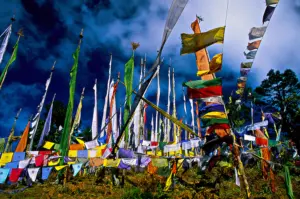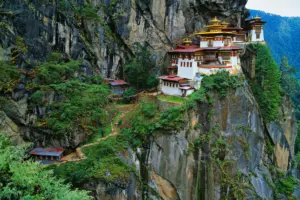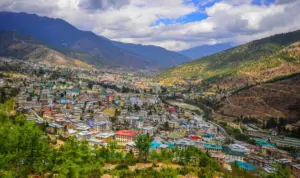Nestled in the Eastern Himalayas, Bhutan stands as a jewel of tranquillity and tradition, earning its moniker as the “Land of the Thunder Dragon.”
In this article, we embark on a virtual journey to unravel the unique charm and cultural richness that define Bhutan. From its majestic monasteries perched on cliff edges to the vibrant festivals that celebrate the kingdom’s heritage, Bhutan invites travellers to explore a realm where Gross National Happiness takes precedence over material measures.
Bhutan Peaks and Prayer Flags

Bhutan Prayer Flags
Himalayan Majesty
Bhutan’s landscape is a spectacle of Himalayan grandeur, boasting some of the world’s highest peaks. The sacred Jomolhari and the revered Gangkhar Puensum punctuate the skyline, offering both spiritual significance and breath-taking vistas for those who venture into Bhutan’s pristine wilderness. The kingdom’s commitment to environmental conservation is evident in its lush forests, which cover over 70% of the land, providing a habitat for unique flora and fauna.
Bhutan Tradition Woven in Threads of Colour
A defining feature of Bhutanese landscapes is the fluttering prayer flags that adorn mountain passes, monasteries, and even humble homes. These vibrant flags, adorned with auspicious symbols, carry prayers on the winds, spreading blessings to the surrounding areas. As travellers navigate through Bhutan’s serene trails, the sight of prayer flags dancing in the breeze becomes a constant companion, a visual representation of the kingdom’s spiritual essence.
Tiger’s Nest – Icon of Bhutanese Spirituality
Perched precariously on a cliffside, the Taktsang Palphug Monastery, or Tiger’s Nest, is an iconic symbol of Bhutanese spirituality. Legend has it that Guru Rinpoche, the second Buddha, flew to this location on the back of a tigress, meditating in the caves that now form part of the monastery. A trek to the Tiger’s Nest is not just a physical journey; it’s a pilgrimage into the heart of Bhutanese faith and reverence.
Bhutan Festivals and Rituals

Ancient Bhutan Monastery
Tshechu – Celebrating Bhutanese Culture
Bhutan’s vibrant cultural tapestry is woven through its traditional festivals, or tshechus, which take place in monasteries and dzongs across the country. These festivals, often featuring masked dances and religious rituals, commemorate significant events in Bhutanese history and honour Guru Rinpoche. The Paro Tshechu, held in the spring, is one of the most renowned, drawing locals and visitors alike to witness the spectacle of Bhutanese traditions.
Archery – Bhutan’s National Sport
In Bhutan, archery is not merely a sport; it’s a cultural phenomenon deeply ingrained in the kingdom’s heritage. Archery competitions, complete with traditional attire and ceremonial rituals, are a common sight during festivals and celebrations. The crack of the bow, the flight of the arrow, and the jubilant cheers of competitors and spectators contribute to the vibrant atmosphere surrounding this national pastime.
Dzongs – Fortresses of Faith and Administration
Dzongs, imposing fortress-monasteries, are integral to Bhutanese culture, serving as both religious centres and administrative hubs. These architectural marvels, with their intricate woodwork and imposing structures, embody the fusion of spiritual and secular authority. The Punakha Dzong, set against the backdrop of the Mo Chhu River, stands as a prime example, exuding a sense of grandeur and historical significance.
Gross National Happiness and Modern Bhutan

Thimphu – Bhutan Capital City
Bhutan Gross National Happiness – A Unique Development Philosophy
Bhutan’s commitment to Gross National Happiness (GNH) sets it apart on the global stage. In a world often measured by economic indicators, Bhutan prioritizes the well-being and happiness of its citizens. GNH encompasses nine domains, including psychological well-being, health, education, and cultural diversity, providing a holistic approach to development that values spiritual, social, and environmental dimensions.
Bhutan’s Unique Approach to Tourism
Tourism in Bhutan is regulated to preserve the kingdom’s culture and environment. The policy of “high-value, low-impact” tourism requires visitors to pay a daily fee, ensuring a more exclusive and sustainable travel experience. This approach safeguards Bhutan’s pristine landscapes and allows travellers to engage more deeply with the local culture, fostering a sense of mutual respect and understanding.
Bhutanese Cuisine – A Gastronomic Adventure
Bhutanese cuisine, characterized by its bold flavours and reliance on red rice, cheese, and chili peppers, offers a culinary adventure for those willing to explore. Ema datshi, a spicy cheese and chili dish, is a Bhutanese staple, reflecting the kingdom’s love for robust and fiery flavours. The culinary journey in Bhutan is not just about the food; it’s an exploration of the kingdom’s cultural diversity and culinary traditions.
In Conclusion: Bhutan’s Timeless Harmony
Bhutan, with its towering peaks, spiritual sanctuaries, and commitment to Gross National Happiness, emerges as a kingdom where tradition and progress exist in harmonious balance.
List of 10 Bhutanese Marvels:
- Tiger’s Nest Monastery
- Bhutanese Tshechus (Festivals)
- Bhutanese Archery
- Dzongs (Fortress-Monasteries)
- Gross National Happiness (GNH)
- Bhutanese Tourism Policy
- Bhutanese Cuisine – Ema Datshi
- Jomolhari and Gangkhar Puensum Peaks
- Bhutanese Prayer Flags
- Bhutanese Landscape and Wilderness
As we conclude our virtual exploration, Bhutan beckons travellers to venture beyond the ordinary, offering a glimpse into a world where serenity, culture, and a deep connection to nature define the very essence of this Himalayan jewel.











